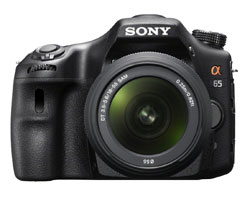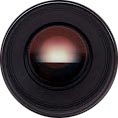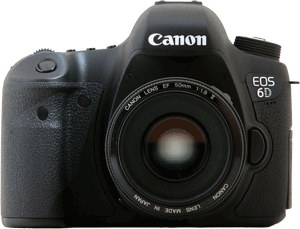Sony SLT-A65 Features
The Sony SLT-A65 features an electronic viewfinder, but you might not know that unless someone told you.
Not sure what an electronic viewfinder is? Or what the alternative is? Not to worry, I'll explain.
Unlike traditional digital SLR cameras, the A65 has a special semi-transparent (or translucent) mirror inside that sits in front of the camera's sensor. This mirror allows some light to pass onto the sensor and it reflects some light to a viewfinder.
In DSLRs made by other manufacturers, this mirror reflects what the lens sees up to an optical viewfinder using an arrangement of mirrors.
Since the SLT-A65 uses a non-traditional mirror, it also doesn't have an optical viewfinder. Instead, the viewfinder inside the A65 is like a tiny video screen stuck in the viewfinder window.
Old electronic viewfinders were hard to use, especially if you moved the camera fast. The video circuits were slow to respond, which resulted in a blurry viewfinder image.
The viewfinder inside the SLT-A65 is not old-time electronics however. It is an XGA OLED (Organic Light Emitting Diode) screen with 2.36 million dots. The greater the dots, the better the picture quality.
Simply put, you should not really notice any difference between this electronic viewfinder and an optical one.
Let's take a closer look at some of the other Sony SLT-A65 features.
Sony SLT-A65 Features
| Megapixels | 24.3 |
|---|---|
| Stabilization | In Body |
| Memory Card | SD / SDHC / SDXC |
| Max. Shutter Speed | 1/4000 |
| Max. Photo Capture | 10 per second |
| ISO Range | 100 to 16000 |
| Movie Modes | AVCHD 1920 x 1080 (60p, 60i, 24p) MP4 1440 x 1080 640 x 480 |
| LCD | Flexible 3in (921,600 dots) |
| Viewfinder | Electronic XGA OLED (2.36 million dots) |
| Autofocus | 15 point |
| Face Detect AF | Yes |
| Sensor Dimensions | 23.5 x 15.6 (1.5x crop factor) |
| HDMI Port | Yes |
| Live View | Yes |
| Built-in Flash | Yes |
| Compatible Lenses | All Sony ALPHA |
| Battery | NP-FM500H LiIon |
| Dimensions | 5.20 x 3.82 x 3.19in 132 x 97 x 81mm |
| Weight | 21oz (622g) |
Features Explained
Sony packs a lot of technology into their digital SLRs — I suppose that's what you get when an electronics company makes a camera. Unfortunately, this tech comes with its own jargon.
While there's a huge variety of photos you can take thanks to the Sony SLT-A65 features, some decoding is required for those who don't speak Sony.
| Translucent Mirror | The translucent mirror simultaneously sends light passing through the lens to both the autofocus system and the camera's sensor. End result: super-fast autofocus when using the viewfinder or LCD for photos and continuous autofocus during video capture. |
|---|---|
| 10 FPS | FPS stands for frames per second or photos per second as I like to call it. In continuous drive mode, the camera will grab images at 10 per second so long as you hold down on the shutter release button. |
| OLED Viewfinder | A drawback of the SLT system is that the viewfinder must be electronic instead of optical. The OLED viewfinder takes electronic viewfinders to the next level, making it hard to tell that you're viewing a small video display inside the viewfinder. |
| Flexible LCD | The LCD on the SLT-A65 flips down from the bottom of the camera and swivels so that you can compose photos and videos from waist level or with the camera high above your head. One drawback of the bottom-flip LCD is that you can't use it with a tripod. |
| HD Movies | The A65 captures movies at different frame rates: 60fps progressive, 60fps interlaced and 24fps progressive. While 24 is the standard used by many film cameras, 60p provides you with the ability to create slow motion effects with your videos (once the video is played back at 30fps). |
| Phase-Detection AF | Phase-detection autofocus is what you'll find in all DSLRs - it's far more accurate and responsive than the contrast-detection autofocus in compact digital cameras. Most DSLRs switch to contrast detection AF in live view mode and when taking video, but the A65 doesn't have to. The translucent mirror provides the A65 with full-time continuous phase-detection autofocus (all 15 points). |
| Auto HDR | HDR stands for High Dynamic Range photography, and it's a technique of combining several different images (under exposed, well exposed, over exposed) into a single image with significantly greater dynamic range. Previously only possible with sophisticated photo editing software, the A65 is able to create HDR images in-camera. |
| Sweep Panorama | You can create panoramic images with the A65 by pressing and holding the shutter release button and "sweeping" the camera across the scenery. The A65 stitches together multiple shots into a single wide panoramic image. |
Where Do I Go From Here?
Join Our Community!
- Learn more about your digital SLR camera
- Get other opinions about camera models
- Share your photos and get feedback
- Learn new DSLR tips and tricks




